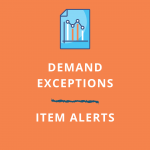Managing Your Coronavirus-Stricken Business: Supply Chain Analytics
Welcome to Part 2 of our series!
IBF’s alarming statistic that 44% of businesses do not have a plan for managing Coronavirus got us thinking, “How can we best help the market, whether folks are using our demand planning software or someone else’s?" So we are blogging one common fear + a solution every day to help you develop (and evolve) your plan, based on what we’re hearing from customers during this unprecedented time.
Yesterday in Part 1 of this series, we blogged about getting out of your comfort zone to assist your customers with alternative services to move inventory, plus why you should not just “zero out” your forecasting.
TODAY'S FEAR: MY KEY CUSTOMERS WON'T GET BUSINESS-CRITICAL ITEMS BECAUSE OTHER CUSTOMERS ARE HOARDING SUPPLY.
SOLUTION: Keep a reserve of those items for key customers set aside. Analytics and customer-level history can help you figure out what that looks like. Also, use analytics around what’s going on now in order to inform next year’s decisions – because there’s a high chance that another disruption of some sort will happen again next year. You’ll want to be in a position to take good care of your customers when it does.
Supply Chain Analytics
 Hopefully "the next disaster" is nothing like Coronavirus, but quite possibly could be the flu, a natural disaster or any other large-scale disruption. Supply chain analytics will be key to the success of your plan.
Hopefully "the next disaster" is nothing like Coronavirus, but quite possibly could be the flu, a natural disaster or any other large-scale disruption. Supply chain analytics will be key to the success of your plan.
Supply chain analytics solutions help you pay very close attention to demand exceptions and item alerts. These allow you to pivot quickly to create excellent customer experiences and competitive advantages.
This Could Spark New Products
The demand exceptions and item alerts (or some similar functionality) within your supply chain analytics system could spark lucrative ideas for new products.
As an example, we work with an automotive parts distributor that recently noticed one of their products (a de-greaser that happened to also contain a hand sanitizer) was certified by the CDC to kill COVID-19. Our system picked up immediately on high demand. The customer was able to filter that spike off and tag it – so they can go back later and see if there was any consistency afterward. If so, this could become a product which, prior to Coronavirus, was just another regular, old item.
In another example, a distillery we work with recognized an unusual demand spike in one of their non-core items, an alcohol product that can be used to make a disinfectant alternative to commercial products such as Purell that are nowhere to be found at the moment. The distillery began making their own disinfectant product, which landed a hefty government contract to mass produce as much of the product as they can, to supply hospitals and other critical applications in the war against Coronavirus.
Now is the time to look at how you track these events year-to-year and get an analytics system in place to automate demand trends and deviations.
LEARN MORE
Unfamiliar with Supply Chain Analytics solutions? Learn more here.
NEXT UP IN PART 3: Managing Your Coronavirus-Stricken Business: 7 Logistics Impacts on Supply Chain
Be sure to follow us on LinkedIn and Twitter for daily updates to this series.


Comments are closed.